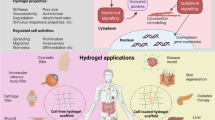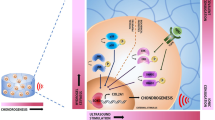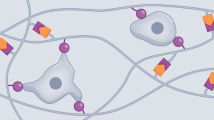Abstract
Cell–matrix interactions have critical roles in regeneration, development and disease. The work presented here demonstrates that encapsulated human mesenchymal stem cells (hMSCs) can be induced to differentiate down osteogenic and adipogenic pathways by controlling their three-dimensional environment using tethered small-molecule chemical functional groups. Hydrogels were formed using sufficiently low concentrations of tether molecules to maintain constant physical characteristics, encapsulation of hMSCs in three dimensions prevented changes in cell morphology, and hMSCs were shown to differentiate in normal growth media, indicating that the small-molecule functional groups induced differentiation. To our knowledge, this is the first example where synthetic matrices are shown to control induction of multiple hMSC lineages purely through interactions with small-molecule chemical functional groups tethered to the hydrogel material. Strategies using simple chemistry to control complex biological processes would be particularly powerful as they could make production of therapeutic materials simpler, cheaper and more easily controlled.
This is a preview of subscription content, access via your institution
Access options
Subscribe to this journal
Receive 12 print issues and online access
$259.00 per year
only $21.58 per issue
Buy this article
- Purchase on Springer Link
- Instant access to full article PDF
Prices may be subject to local taxes which are calculated during checkout




Similar content being viewed by others
References
Amis, E. J. Combinatorial materials science: Reaching beyond discovery. Nature Mater. 3, 83–85 (2004).
Bianco, P., Riminucci, M., Gronthos, S. & Robey, P. G. Bone marrow stromal stem cells: Nature, biology, and potential applications. Stem Cells 19, 180–192 (2001).
Meredith, J. C. et al. Combinatorial characterization of cell interactions with polymer surfaces. J. Biomed. Mater. Res. A 66, 483–490 (2003).
Saha, K., Pollock, J. F., Schaffer, D. V. & Healy, K. E. Designing synthetic materials to control stem cell phenotype. Curr. Opin. Chem. Biol. 11, 381–387 (2007).
Anderson, D. G., Levenberg, S. & Langer, R Nanoliter-scale synthesis of arrayed biomaterials and its application to human embryonic stem cells. Nature Biotechnol. 22, 863–866 (2004).
Keselowsky, B. G., Collard, D. M. & Garcia, A. J. Surface chemistry modulates fibronectin conformation and directs integrin binding and specificity to control cell adhesion. J. Biomed. Mater. Res. A 66, 247–259 (2003).
Meyer, U. et al. Attachment kinetics and differentiation of osteoblasts on different biomaterials. Cells Mater. 3, 129–140 (1993).
Vanwachem, P. B. et al. Adhesion of cultured human-endothelial cells onto methacrylate polymers with varying surface wettability and charge. Biomaterials 8, 323–328 (1987).
Webb, K., Hlady, V. & Tresco, P. A. Relative importance of surface wettability and charged functional groups on NIH 3T3 fibroblast attachment, spreading, and cytoskeletal organization. J. Biomed. Mater. Res. 41, 422–430 (1998).
Nuttelman, C. R., Benoit, D. S. W., Tripodi, M. C. & Anseth, K. S. The effect of ethylene glycol methacrylate phosphate in PEG hydrogels on mineralization and viability of encapsulated hMSCs. Biomaterials 27, 1377–1386 (2006).
Flaim, C. J., Chien, S. & Bhatia, S. N. An extracellular matrix microarray for probing cellular differentiation. Nature Methods 2, 119–125 (2005).
Anderson, D. G., Putnam, D., Lavik, E. B., Mahmood, T. A. & Langer, R. Biomaterial microarrays: rapid, microscale screening of polymer-cell interaction. Biomaterials 26, 4892–4897 (2005).
Engler, A. J., Sen, S., Sweeney, H. L. & Discher, D. E. Matrix elasticity directs stem cell lineage specification. Cell 126, 677–689 (2006).
McBeath, R., Pirone, D. M., Nelson, C. M., Bhadriraju, K. & Chen, C. S. Cell shape, cytoskeletal tension, and RhoA regulate stem cell lineage commitment. Dev. Cell 6, 483–495 (2004).
Caplan, A. I. Mesenchymal stem cells: Cell-based reconstructive therapy in orthopedics. Tissue Eng. 11, 1198–1211 (2005).
Barry, F. P. & Murphy, J. M. Mesenchymal stem cells: clinical applications and biological characterization. Int. J. Biochem. Cell Biol. 36, 568–584 (2004).
Kuo, C. K. & Tuan, R. S. Tissue engineering with mesenchymal stem cells. IEEE Eng. Med. Biol. Mag. 22, 51–56 (2003).
Herring, G. M. Chemical structure of tendon cartilage dentin and bone matrix. Clin. Orthop. Rel. Res. 60, 261–299 (1968).
Murphy, W. L. & Mooney, D. J. Bioinspired growth of crystalline carbonate apatite on biodegradable polymer substrata. J. Am. Chem. Soc. 124, 1910–1917 (2002).
Goldrick, R. B. Morphological changes in adipocyte during fat deposition and mobilization. Am. J. Physiol. 212, 777–782 (1967).
Reardon, M. F., Goldrick, R. B. & Fidge, N. H. Dependence of rates of lipolysis, esterification, and free fatty-acid release in isolated fat-cells on age, cell size, and nutritional state. J. Lipid Res. 14, 319–326 (1973).
Mackay, A. M. et al. Chondrogenic differentiation of cultured human mesenchymal stem cells from marrow. Tissue Eng. 4, 415–428 (1998).
Mayne, R., Vail, M. S., Mayne, P. M. & Miller, E. J. Changes in type of collagen synthesized as clones of chick chondrocytes grow and eventually lose division capacity. Proc. Natl Acad. Sci. USA 73, 1674–1678 (1976).
Burdick, J. A. & Anseth, K. S. Photoencapsulation of osteoblasts in injectable RGD-modified PEG hydrogels for bone tissue engineering. Biomaterials 23, 4315–4323 (2002).
Bryant, S. J. & Anseth, K. S. Hydrogel properties influence ECM production by chondrocytes photoencapsulated in poly(ethylene glycol) hydrogels. J. Biomed. Mater. Res. 59, 63–72 (2002).
Beqaj, S., Jakkaraju, S., Mattingly, R. R., Pan, D. & Schuger, L. High RhoA activity maintains the undifferentiated mesenchymal cell phenotype, whereas RhoA down-regulation by laminin-2 induces smooth muscle myogenesis. J. Cell Biol. 156, 893–903 (2002).
Chastain, S. R., Kundu, A. K., Dhar, S., Calvert, J. W. & Putnam, A. J. Adhesion of mesenchymal stem cells to polymer scaffolds occurs via distinct ECM ligands and controls their osteogenic differentiation. J. Biomed. Mater. Res. A 78, 73–85 (2006).
Mandrup, S. & Lane, M. D. Regulating adipogenesis. J. Biol. Chem. 272, 5367–5370 (1997).
Selvarajan, S., Lund, L. R., Takeuchi, T., Craik, C. S. & Werb, Z. A plasma kallikrein-dependent plasminogen cascade required for adipocyte differentiation. Nature Cell Biol. 3, 267–275 (2001).
Smas, C. M. & Sul, H. S. Control of adipocyte differentiation. Biochem. J. 309, 697–710 (1995).
Gregoire, F. M., Smas, C. M. & Sul, H. S. Understanding adipocyte differentiation. Physiol. Rev. 78, 783–809 (1998).
Spiegelman, B. M. & Ginty, C. A. Fibronectin modulation of cell-shape and lipogenic gene-expression in 3t3-adipocytes. Cell 35, 657–666 (1983).
Mann, B. K., Gobin, A. S., Tsai, A. T., Schmedlen, R. H. & West, J. L. Smooth muscle cell growth in photopolymerized hydrogels with cell adhesive and proteolytically degradable domains: synthetic ECM analogs for tissue engineering. Biomaterials 22, 3045–3051 (2001).
Gobin, A. S. & West, J. L. Val-ala-pro-gly, an elastin-derived non-integrin ligand: Smooth muscle cell adhesion and specificity. J. Biomed. Mater. Res. A 67, 255–259 (2003).
DeLong, S. A., Gobin, A. S. & West, J. L. Covalent immobilization of RGDS on hydrogel surfaces to direct cell alignment and migration. J. Control. Release 109, 139–148 (2005).
Gobin, A. S. & West, J. L. Effects of epidermal growth factor on fibroblast migration through biomimetic hydrogels. Biotechnol. Prog. 19, 1781–1785 (2003).
Benoit, D. S. W. & Anseth, K. S. The effect on osteoblast function of colocalized RGD and PHSRN epitopes on PEG surfaces. Biomaterials 26, 5209–5220 (2005).
Masters, K. S., Shah, D. N., Walker, G., Leinwand, L. A. & Anseth, K. S. Designing scaffolds for valvular interstitial cells: Cell adhesion and function on naturally derived materials. J. Biomed. Mater. Res. A 71, 172–180 (2004).
Benoit, D. S. W., Nuttelman, C. R., Collins, S. D. & Anseth, K. S. Synthesis and characterization of a fluvastatin-releasing hydrogel delivery system to modulate hMSC differentiation and function for bone regeneration. Biomaterials 27, 6102–6110 (2006).
Benoit, D. S. W. & Anseth, K. S. Heparin functionalized PEG gels that modulate protein adsorption for hMSC adhesion and differentiation. Acta Biomater. 1, 461–470 (2005).
Bryant, S. J., Arthur, J. A. & Anseth, K. S. Incorporation of tissue-specific molecules alters chondrocyte metabolism and gene expression in photocrosslinked hydrogels. Acta Biomater. 1, 243–252 (2005).
Acknowledgements
This work was supported by a grant from the National Institute of Health (DE016523). The authors would like to thank C. Bowman and H. Sikes for use of and assistance with the ChipWriter, K. Rowlen and E. Dawson for use of and help with the ChipReader, E. Kovacs for technical assistance associated with in situ hybridization and J. McCormick and S. George for assistance with the X-ray photoelectron spectroscopy studies. Fellowship assistance to D.S.W.B. was awarded by the US Department of Education’s Graduate Assistantships in Areas of National Need program and the National Science Foundation Graduate Research Fellowship program.
Author information
Authors and Affiliations
Contributions
D.S.W.B. and K.S.A. came up with the concept, D.S.W.B., M.P.S. and K.S.A. designed the experiments, D.S.W.B. and A.R.D. carried out the experiments and D.S.W.B., M.P.S. and K.S.A. wrote the paper.
Corresponding author
Supplementary information
Supplementary Information
Supplementary Information (PDF 1506 kb)
Rights and permissions
About this article
Cite this article
Benoit, D., Schwartz, M., Durney, A. et al. Small functional groups for controlled differentiation of hydrogel-encapsulated human mesenchymal stem cells. Nature Mater 7, 816–823 (2008). https://doi.org/10.1038/nmat2269
Received:
Accepted:
Published:
Issue Date:
DOI: https://doi.org/10.1038/nmat2269
This article is cited by
-
Comparison of the ability of exosomes and ectosomes derived from adipose-derived stromal cells to promote cartilage regeneration in a rat osteochondral defect model
Stem Cell Research & Therapy (2024)
-
Nanotopography reveals metabolites that maintain the immunomodulatory phenotype of mesenchymal stromal cells
Nature Communications (2023)
-
Hydrogels as functional components in artificial cell systems
Nature Reviews Chemistry (2022)
-
Development of a functional salivary gland tissue chip with potential for high-content drug screening
Communications Biology (2021)
-
Hydrogel Properties May Influence Mesenchymal Stem Cell Lineage Progression Through Modulating GAPDH Activity
Regenerative Engineering and Translational Medicine (2021)



